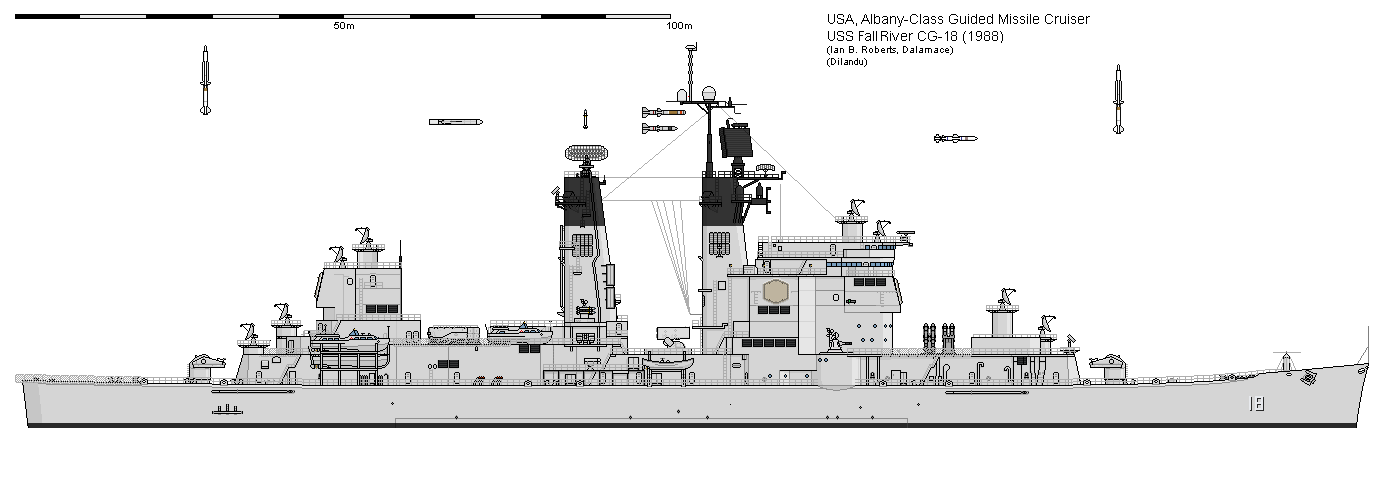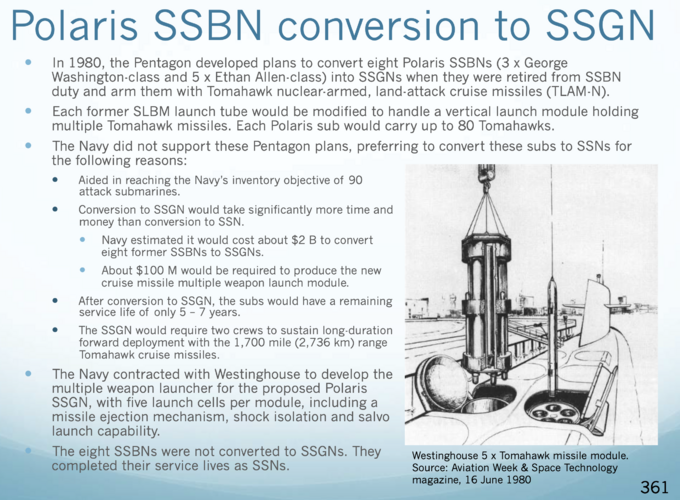Dilandu
I'm dissatisfied, which means, I exist.
Yes, yes, I fully understood that it's impractical and unrealistic, but I just like "Albany"-class cruisers, and just before New Year I hit the idea "what if Albany-class cruiser would be refitted in 80s to carry Aegis?"
Oh, and a Happy New Year)

So yes, it's CG-18 "Fall River" missile cruiser, refitted in mid-1980s into Aegis ship.
Displacement: 18.000 tons full load
Dimensions: as of "Albany"-class
Weaponry:
* two Mk-12 Mod 3 twin GMLS for RIM-68 SM-2LR "Stalos" (a "Standard"-based solid-fuel ramjet missile with RIM-67 booster, for 200+ km range interceptions) - 104 missiles
* two Goalkeeper CIWS
* two Sea Chaparral Mk.2 GMLS (with both IR-homing and radar-homing AIM-9C derivative capabilities) - 64 misisles
* two four-canister RGM-84 Harpoon launchers - 8 missiles
* two four-canister BGM-109 Tomahawk launchers - 8 missiles
* one Mk-12 ASROC launcher - 8 rockets
* provision for two Mk.105 rocket launchers installation (not fitted)
Sensors & electronics:
* AN/SPY-1 search/tracking radar
* AN/SPS-39 integrated radar/IFF interrogator
* AN/SPS-49 air search radar
* Eight AN/SPG-51F "universal" fire control radar (Aegis-integrated)
* AN/SLQ-32(V)3 ECM set
History:
By early 1980s, USN grew concerned about the situation with the fleet of "Albany"-class missile cruisers. There were eight of them in service, reconstructed in two series (first series consisted of "Albany", "Chicago" and "Columbus", second series consisted of "Fall River", "Macon", "Toledo", "Rochester" and "Los-Angeles") from WW2-era heavy cruiser hulls. Boasting an impressive battery of long-range RIM-8 "Talos" and short-range RIM-24 "Tartar" missiles, those cruisers were considered the backbone of carrier escorts - the USN efficient answer to the growing power of Soviet carrier-based aviation.
All second series ships underwent the major refit in 1970s, replacing their outdated RIM-8 "Talos" missile system with RIM-68 SM-1LR "Stalos" - a long-range missile of "Standard" family, using the RIM-67 booster together with solid-fuel ramjet upper stage (delivered from early 60s experiments with CROW test vechicle). Their fire control system on them was massively overhauled, replacing each clumsy combination of AN/SPG-49 & AN/SPG-51 radar pair with a single AN/SPG-51E radar. This refit provided cruisers with eight integrated fire control channels (counting the ones used for self-defense RIM-24 Terrier/RIM-66 SM-1 missile launchers on broadside), which was quite an impressive capability. Still, those ships were aging, and should be either replaced, or given another major refit soon.
The idea of another major overhaul of "Albany"-class cruiser was born out of realization, that it would be financially and pracitcally impossible to build enough of Aegis Combat System-equipped nuclear missile cruisers to replace all old units in the fleet. Since the concept of Aegis-equipped destroyer was scrapped due to weight and cost concerns, USN started to look around its supply of large, cruiser-size hulls, that could be converted into Aegis units.
The review of the cruiser fleet concluded, that three of "Albany"-class cruisers - CG-18 "Fall River", CG-19 "Toledo" and CG-21 "Macon" - still in good enough condition for at least a decade of useful servie life. While the idea of putting sophisticated digital era Aegis system on World War 2 era hulls caused a lot of raised eyebrows, the proponents of the idea pointed out that those hulls are big, very stable, and could easily hande the massive phased array radars (as well as superstructure extensions, required to house them). And therefore in 1981 the two-years upgrade for three "Albany"-class shups was approved.
On all three ships, the forward superstructure was given a starboard extension, allowing to fit the forward and starboard-facing AN/SPY-1 radar arrays. The aft mast was completely replaced with a new compact superstructure, housing aft and port-facing AN/SPY-1 arrays. Since such arrangement made the use of starboard Mk-11 SM-1MR launchers impossible, both starboard and port launchers were removed, and license-build Goalkeeper CIWS were installed in their place. Such "assymetrical" arrangement wasn't exactly good-looking, but it was perfectly functional.
The main weaponry now consisted of Aegis-compatible RIM-68D/E/F SM-2LR missiles. The RIM-68D version was a semi-active radar homing version, capable of 250+ km interception range. The RIM-68E was the nuclear-capable version of RIM-68D, fitted with sub-kiloton warhead. Finally, the RIM-68F was a highly specific "autonomous Stalos" - equipped with active radar seeker, developed from AIM-54 AAM, and capable of autonomous search of low-altitude targets (that could not be illuminated by ship's own radar). The capability of fitting the supersonic RGM-68 "Spearfish" missile - the anti-ship "Stalos" derivative with radar altimeter for low-altitude flight and RGM-66F delivered radar seeker - was also retained. Eight new AN/SPG-51F Aegis-compatible fire control radars were fitted, four of them moved from broadside position to the top of forward and aft superstructure.
The old artillery mounts on sides of second funnel were also removed - their efficiency was in doubt even in 1960s, to be fair - and a trusted RIM-72C "Sea Chaparral" was installed instead. The mount have fire control system integration, and compact tracking/illuminating radar for RIM-72J semi-active homing missiles (developed from AIM-9C AAM). Finally, the strike weapon package - eight "Harpoon" anti-ship missiles and eight "Tomahawk" land attack missiles were installed on the top of missile housing (old cranes for missile reload in sea were removed).
The refitted cruisers entered service in 1985-1988, together with the first of second-generation Aegis nuclear cruisers of "Montana"-class.
Oh, and a Happy New Year)

So yes, it's CG-18 "Fall River" missile cruiser, refitted in mid-1980s into Aegis ship.
Displacement: 18.000 tons full load
Dimensions: as of "Albany"-class
Weaponry:
* two Mk-12 Mod 3 twin GMLS for RIM-68 SM-2LR "Stalos" (a "Standard"-based solid-fuel ramjet missile with RIM-67 booster, for 200+ km range interceptions) - 104 missiles
* two Goalkeeper CIWS
* two Sea Chaparral Mk.2 GMLS (with both IR-homing and radar-homing AIM-9C derivative capabilities) - 64 misisles
* two four-canister RGM-84 Harpoon launchers - 8 missiles
* two four-canister BGM-109 Tomahawk launchers - 8 missiles
* one Mk-12 ASROC launcher - 8 rockets
* provision for two Mk.105 rocket launchers installation (not fitted)
Sensors & electronics:
* AN/SPY-1 search/tracking radar
* AN/SPS-39 integrated radar/IFF interrogator
* AN/SPS-49 air search radar
* Eight AN/SPG-51F "universal" fire control radar (Aegis-integrated)
* AN/SLQ-32(V)3 ECM set
History:
By early 1980s, USN grew concerned about the situation with the fleet of "Albany"-class missile cruisers. There were eight of them in service, reconstructed in two series (first series consisted of "Albany", "Chicago" and "Columbus", second series consisted of "Fall River", "Macon", "Toledo", "Rochester" and "Los-Angeles") from WW2-era heavy cruiser hulls. Boasting an impressive battery of long-range RIM-8 "Talos" and short-range RIM-24 "Tartar" missiles, those cruisers were considered the backbone of carrier escorts - the USN efficient answer to the growing power of Soviet carrier-based aviation.
All second series ships underwent the major refit in 1970s, replacing their outdated RIM-8 "Talos" missile system with RIM-68 SM-1LR "Stalos" - a long-range missile of "Standard" family, using the RIM-67 booster together with solid-fuel ramjet upper stage (delivered from early 60s experiments with CROW test vechicle). Their fire control system on them was massively overhauled, replacing each clumsy combination of AN/SPG-49 & AN/SPG-51 radar pair with a single AN/SPG-51E radar. This refit provided cruisers with eight integrated fire control channels (counting the ones used for self-defense RIM-24 Terrier/RIM-66 SM-1 missile launchers on broadside), which was quite an impressive capability. Still, those ships were aging, and should be either replaced, or given another major refit soon.
The idea of another major overhaul of "Albany"-class cruiser was born out of realization, that it would be financially and pracitcally impossible to build enough of Aegis Combat System-equipped nuclear missile cruisers to replace all old units in the fleet. Since the concept of Aegis-equipped destroyer was scrapped due to weight and cost concerns, USN started to look around its supply of large, cruiser-size hulls, that could be converted into Aegis units.
The review of the cruiser fleet concluded, that three of "Albany"-class cruisers - CG-18 "Fall River", CG-19 "Toledo" and CG-21 "Macon" - still in good enough condition for at least a decade of useful servie life. While the idea of putting sophisticated digital era Aegis system on World War 2 era hulls caused a lot of raised eyebrows, the proponents of the idea pointed out that those hulls are big, very stable, and could easily hande the massive phased array radars (as well as superstructure extensions, required to house them). And therefore in 1981 the two-years upgrade for three "Albany"-class shups was approved.
On all three ships, the forward superstructure was given a starboard extension, allowing to fit the forward and starboard-facing AN/SPY-1 radar arrays. The aft mast was completely replaced with a new compact superstructure, housing aft and port-facing AN/SPY-1 arrays. Since such arrangement made the use of starboard Mk-11 SM-1MR launchers impossible, both starboard and port launchers were removed, and license-build Goalkeeper CIWS were installed in their place. Such "assymetrical" arrangement wasn't exactly good-looking, but it was perfectly functional.
The main weaponry now consisted of Aegis-compatible RIM-68D/E/F SM-2LR missiles. The RIM-68D version was a semi-active radar homing version, capable of 250+ km interception range. The RIM-68E was the nuclear-capable version of RIM-68D, fitted with sub-kiloton warhead. Finally, the RIM-68F was a highly specific "autonomous Stalos" - equipped with active radar seeker, developed from AIM-54 AAM, and capable of autonomous search of low-altitude targets (that could not be illuminated by ship's own radar). The capability of fitting the supersonic RGM-68 "Spearfish" missile - the anti-ship "Stalos" derivative with radar altimeter for low-altitude flight and RGM-66F delivered radar seeker - was also retained. Eight new AN/SPG-51F Aegis-compatible fire control radars were fitted, four of them moved from broadside position to the top of forward and aft superstructure.
The old artillery mounts on sides of second funnel were also removed - their efficiency was in doubt even in 1960s, to be fair - and a trusted RIM-72C "Sea Chaparral" was installed instead. The mount have fire control system integration, and compact tracking/illuminating radar for RIM-72J semi-active homing missiles (developed from AIM-9C AAM). Finally, the strike weapon package - eight "Harpoon" anti-ship missiles and eight "Tomahawk" land attack missiles were installed on the top of missile housing (old cranes for missile reload in sea were removed).
The refitted cruisers entered service in 1985-1988, together with the first of second-generation Aegis nuclear cruisers of "Montana"-class.



